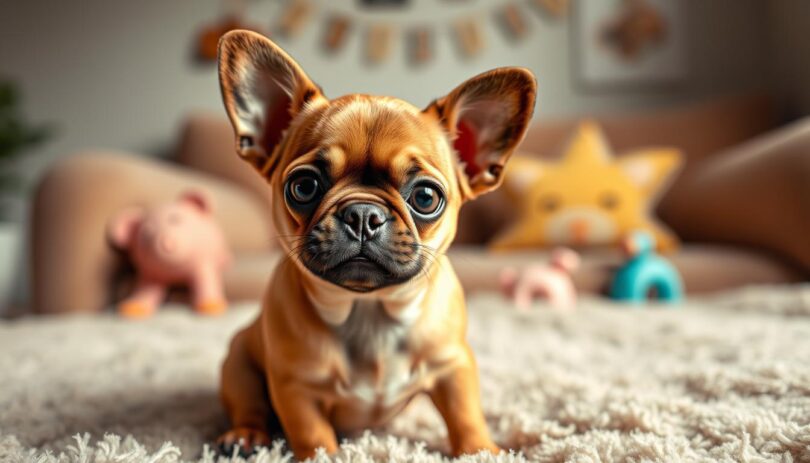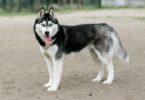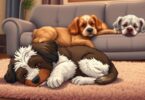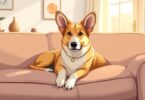What happens when two of the most beloved small dog breeds combine into one irresistible package? Meet the Chug—a playful crossbreed stealing hearts with its quirky charm and loyal personality.
Often called a Pughuahua or Pugwawa, this hybrid blends the boldness of a Chihuahua with the easygoing nature of a Pug. Though not officially recognized by the AKC, their popularity continues to rise among urban dwellers and families alike.
This guide dives into everything you need to know about these compact companions. Learn about their unique appearance, spirited temperament, and ideal living conditions. We’ll also explore health considerations, training tips, and grooming routines tailored to their needs.
Why choose a Chug? Their adaptability makes them perfect for apartments or houses, and their affectionate demeanor suits households with older children. Whether you’re a first-time owner or a seasoned pet parent, you’ll discover practical advice to help your furry friend thrive.
Introduction to the Chihuahua Pug Mix
Urban pet lovers are increasingly drawn to a compact companion that marries spunk with sweetness—the Chug dog. This hybrid combines the bold confidence of a Chihuahua with the mellow charm of a Pug, creating a loyal friend perfect for modern lifestyles. Though not an official breed, these dogs have surged in popularity over the last decade, especially among city dwellers.
Chugs typically weigh 10-20 pounds and stand under 14 inches tall, making them ideal for apartments. Their appearance varies widely—some inherit the Pug’s wrinkled face, while others showcase the Chihuahua’s expressive eyes. Coat colors range from fawn to black, often with unique markings.
What truly sets these dogs apart is their dynamic personality. They balance playful energy with affectionate snuggles, adapting easily to quiet evenings or lively walks. While generally social, early socialization helps them interact confidently with children and other pets.
This guide explores how to care for your Chug’s health, exercise needs, and grooming routines. You’ll discover why their adaptable nature makes them a top choice for first-time owners and experienced dog enthusiasts alike.
History and Origin of the Chihuahua Pug Mix
Combining two iconic breeds, the Chug emerged as a testament to selective breeding trends. This hybrid first appeared in the early 2000s when breeders aimed to blend the Chihuahua’s spirited personality with the Pug’s relaxed demeanor. Unlike established dog breeds with centuries-old lineages, the Chug remains unregistered by the AKC due to its recent development.
Designer breeds like the Chug lack official standards since their traits vary widely. Some inherit the Pug’s compact frame and wrinkled face, while others showcase the Chihuahua’s alert expression. This unpredictability stems from combining breeds with distinct histories—the Pug’s royal Chinese roots contrast sharply with the Chihuahua’s Mexican heritage.
Social media propelled the Chug’s popularity, with owners sharing their pets’ quirky antics online. Viral posts highlighted their adaptable nature, making them ideal for apartment living. However, ethical breeding remains critical to minimize health risks tied to flat-faced features inherited from Pug parents.
Understanding this mix’s background helps explain its diverse appearance and temperament. Responsible breeders prioritize health screenings over aesthetics, ensuring these companions thrive in modern households. Their story reflects a growing preference for compact, low-maintenance pets suited to urban lifestyles.
Physical Appearance and Size Characteristics
A mix of bold and charming traits defines the Chug’s physical characteristics. These compact dogs typically weigh under 18 pounds, making them ideal for small spaces. Their height rarely exceeds 14 inches, combining the sturdy build of one parent with the delicate frame of the other.
Comparing Parental Traits
Skull shape often reveals which breed dominates. Some inherit the rounded, apple-dome skull of their smaller ancestor, while others showcase a flatter profile. Ears might stand erect or fold softly, and muzzles range from short and pointed to gently flattened.
Facial expressions steal the show. Large, soulful eyes peer out from features that may include subtle wrinkles or a smooth brow. These variations create endless combinations—no two dogs look exactly alike.
Coat Diversity and Markings
The coat stays short and low-maintenance in most cases. Colors span fawn, cream, and brindle, often with white accents on the chest or paws. A smooth texture inherited from both parents ensures easy grooming.
Unique markings add personality. Some display a dark “mask” around the eyes, while others sport speckled legs. Despite their small size, these dogs carry themselves with confidence, blending playful energy with an endearing physique.
Temperament and Personality Overview
A whirlwind of charm and quirks defines the Chug’s personality. These compact companions blend lively energy with deep loyalty, creating a dynamic temperament that adapts to various lifestyles. Their behavior often reflects a mix of playful curiosity and affectionate devotion, making them ideal for owners seeking both entertainment and companionship.
Behavioral Traits and Social Needs
Expect bursts of enthusiasm followed by cozy lap time. These dogs thrive on interactive play but may display stubborn streaks during training. Consistent positive reinforcement works best for teaching commands and curbing excessive barking.
Early socialization shapes their confidence. Introduce them to diverse environments, people, and animals during puppyhood. This prevents overprotectiveness and helps them develop balanced behavior patterns.
Interaction with Family and Other Pets
Chugs bond strongly with their human families, often shadowing their favorite person. They interact well with older children who respect their small size. Supervised playdates teach gentle handling and strengthen trust.
With proper introductions, most adapt to multi-pet households. Slow, positive encounters help them accept cats or other dogs. Their temperament varies—some inherit more social tendencies, while others prefer being the sole pet.
A well-socialized Chug becomes a joyful family member. Their adaptable nature and loving personality make them excellent companions for city dwellers and suburban families alike.
Health and Life Expectancy Considerations
Maintaining your companion’s well-being requires understanding their unique health profile. These energetic dogs often live 13-16 years with proper care, but certain inherited conditions demand attention.
Common Inherited Challenges
Brachycephalic airway syndrome often affects dogs with flat facial features, causing breathing difficulties. Eye issues like corneal ulcers and joint problems such as patellar luxation are also frequent. Dental disease ranks high due to crowded teeth common in smaller breeds.
Proactive Wellness Strategies
Schedule biannual vet checkups to catch issues early. Monitor weight closely—obesity worsens joint stress and breathing problems. Brush their teeth three times weekly and opt for professional cleanings when needed.
Watch for limping or excessive panting, which could signal underlying conditions. Spaying/neutering reduces cancer risks while maintaining lean muscle mass through measured feeding supports longevity. Partner with your veterinarian to create tailored prevention plans.
Nutrition and Feeding Guidelines
Fueling your Chug’s playful energy starts with smart nutrition choices. Puppies need four small meals daily to stabilize blood sugar and support growth. Adults thrive on two portions of balanced diet formulas designed for small breeds.
Choose kibble sized for tiny jaws to prevent choking. Look for AAFCO-compliant foods rich in animal protein (30-40%) to maintain muscle mass. Monitor your pet’s weight monthly—adjust portions if their waistline disappears or ribs become visible.
Treats should complement meals, not replace them. Use soft training rewards sparingly—under 10% of daily calories. Freeze-dried liver or carrot slices work well for sensitive stomachs.
Consult your veterinarian to tailor plans for allergies or activity levels. Senior dogs may need joint-supporting nutrients, while active adults benefit from calorie-dense formulas. Always transition foods gradually over 7-10 days to avoid digestive upset.
Exercise and Activity Requirements
Keeping your Chug healthy involves more than just regular vet visits—it starts with tailored exercise routines. Daily moderate activity prevents weight gain and supports joint health, crucial for this small dog breed. Short walks split into morning and evening sessions work best, paired with indoor games like fetch or tug-of-war.
These dogs thrive on variety. Puzzle toys challenge their minds, while hide-and-seek taps into natural curiosity. Avoid intense workouts in hot weather, as their short snouts can cause breathing difficulties. Instead, opt for swimming or gentle play in shaded areas.
Apartment-friendly activities make exercise manageable. Create mini obstacle courses using cushions or teach new tricks during training sessions. Consistency matters—establish a schedule that aligns with your family’s routine to reinforce good behavior.
Mental stimulation is just as vital as physical exertion. Rotate toys weekly to maintain interest, and incorporate scent games during walks. This balanced approach reduces destructive habits while promoting overall well-being for your lively companion.
Grooming and Coat Care Tips
Maintaining your companion’s sleek appearance requires simple yet consistent grooming habits. While their short coat needs minimal upkeep, regular care prevents common issues and keeps them comfortable. A proper routine combines brushing, bathing, and targeted hygiene practices.
Daily Brushing and Bathing Recommendations
Brush your dog weekly using a soft-bristle tool to remove loose fur and distribute natural oils. Increase to twice weekly during seasonal shedding. Baths every 4-6 weeks work best—use lukewarm water and canine-specific shampoo to protect their skin’s pH balance.
Dry thoroughly after washing, paying attention to skin folds where moisture lingers. Avoid over-bathing, which can cause dryness. For quick cleanups between baths, wipe their coat with a damp cloth.
Dental, Ear, and Skin Care Essentials
Brush teeth three times weekly with a finger brush and pet-safe toothpaste. Annual veterinary dental cleanings prevent tartar buildup. Check ears weekly for redness or odor, gently wiping the outer canal with a vet-approved solution.
Inspect facial wrinkles daily, cleaning them with a soft, damp cloth to prevent infections. Monitor eyes for discharge and keep the area dry. Schedule regular nail trims and paw pad checks to complete their grooming routine.
Behavioral and Training Strategies
Building a strong bond with your Chug starts with smart training techniques that respect their unique personality. Begin sessions during puppyhood to shape positive habits early. Short, daily practices using treats or praise work better than marathon drills.
Rewards-based methods boost cooperation. Teach “sit,” “stay,” and “come” first—these commands create structure. Pair verbal cues with hand signals for clearer communication. Always end on a success to keep training enjoyable.
Socialization prevents fear-based behaviors. Introduce puppies to parks, car rides, and friendly strangers by 16 weeks. Supervised playdates with calm dogs build confidence. Rotate environments to help them adapt to new sights and sounds.
Address stubbornness with patience, not punishment. Redirect excessive barking using the “quiet” command followed by a treat. For leash pulling, stop walking until tension eases. Consistency is key—mixed signals confuse these clever dogs.
Incorporate training into daily routines. Practice “wait” before meals or “down” during TV time. Five-minute games like hide-and-seek reinforce obedience while burning energy. A well-trained Chug becomes a joyful, well-adjusted family member.
Living Environment and Home Compatibility
Creating a nurturing space for your compact companion starts with understanding their environmental needs. These adaptable dogs thrive in apartments and cozy homes where they feel secure. Their small size means they don’t require sprawling yards, making them perfect for urban living.
Designate a quiet corner with a plush bed for downtime. Use baby gates to block staircases or unsafe zones in active households. Soft rugs near furniture help prevent slips when your pet jumps down.
Establish predictable meal times and walk schedules to reduce stress. Store cleaning supplies in locked cabinets and secure loose wires to protect curious explorers. Families with young children should teach gentle handling techniques to avoid accidental injuries.
A calm atmosphere minimizes anxiety-driven behaviors like chewing. Soft background music during alone time can soothe sensitive dogs. Balance indoor relaxation with daily outdoor adventures—short walks or balcony sunbathing sessions meet their stimulation needs.
Pair cozy indoor spaces with interactive toys to keep minds engaged. This approach ensures your pet remains content whether you’re in a studio apartment or suburban home. Consistent routines and thoughtful safety measures create harmony for everyone.
The “chihuahua pug mix” in Focus
The Chug dog’s rise to fame isn’t just luck—it’s a perfect storm of hybrid vigor and irresistible charm. Unlike many crossbreeds, this mix consistently delivers a balance of playful energy and affectionate loyalty. Their compact size and expressive features create instant appeal, but it’s their adaptable nature that truly sets them apart from other designer dogs.
These companions often showcase a fascinating duality. One moment they’re zipping around with terrier-like enthusiasm, the next they’re curled up like a living heating pad. This blend stems from merging the bold confidence of one parent with the easygoing warmth of the other, creating a temperament that suits both active singles and laid-back families.
Social media played a pivotal role in boosting their popularity. Viral videos highlight their comedic antics and portable size, making them ideal for urban lifestyles. Unlike larger hybrids, Chugs adapt seamlessly to apartment living while still craving interactive play sessions.
Each dog’s appearance and behavior remain delightfully unpredictable. Some inherit prominent eyes that spark curiosity, while others sport wrinkled brows that melt hearts. This variability ensures no two chug dogs are exactly alike, though all share a knack for forming deep bonds with their humans.
Families increasingly choose these hybrids for their resilience. Many transition from anxious shelter behaviors to playful companions when given stable homes. Their manageable exercise needs and low-maintenance grooming further explain why they’re outpacing many established breeds in adoption rates.
Breeder Selection and Adoption Advice
Finding your perfect companion starts with making informed choices about their origin. Reputable breeders prioritize genetic health over aesthetics, conducting eye exams and patella evaluations for parent dogs. Always request documentation of these tests and inquire about the lineage’s history with breathing issues or dental concerns.
Visit breeding facilities personally to assess living conditions. Ethical professionals welcome questions about socialization methods and provide lifetime support guarantees. They’ll explain how they monitor puppies’ weight and match temperaments to adopters’ lifestyles.
Adoption offers equally rewarding opportunities. Rescue groups often have Chugs needing homes, with many already trained and vet-checked. These organizations typically share detailed care histories, helping you understand your pet’s needs from day one.
Whether adopting or buying, verify credentials through breed clubs or the AKC Marketplace. Avoid sellers focusing solely on “rare” colors or low prices—these often skip crucial health screenings. Responsible sources prioritize the dogs’ long-term wellbeing, ensuring your Chug becomes a joyful family member for years.
Essential Care and Daily Maintenance Tips
Consistent care routines transform daily pet ownership from chaotic to harmonious. For compact companions, structure provides security while meeting their physical and emotional needs. Start with predictable meal times—feed adult dogs twice daily using measured portions to prevent overeating.
Establishing a Routine and Safe Space
Designate a quiet corner with a plush bed and favorite toys. This retreat helps dogs recharge after play or during loud household activities. Pair this sanctuary with scheduled walks and interactive games to balance energy levels.
Incorporate grooming into your pet’s routine. Brush their coat weekly and wipe facial folds daily to prevent irritation. Add toothbrushing sessions three times weekly using poultry-flavored paste for easier acceptance.
Stick to fixed wake-up times and evening wind-down rituals. Dogs thrive when they know what to expect, reducing stress-related behaviors like chewing or excessive barking. Rotate puzzle toys and scent games to stimulate their problem-solving skills without overwhelming them.
Watch for changes in appetite or sleep patterns—these often signal health concerns. Adjust routines gradually if needed, maintaining core elements like feeding schedules. A stable environment helps your companion feel secure, strengthening your bond over time.
Common Challenges and Problem Behaviors
Every pet owner faces challenges, and Chug parents are no exception. These spirited dogs may develop separation anxiety, excessive barking, or stubborn tendencies without proper guidance. Recognizing these issues early helps create effective solutions.
Separation anxiety often manifests through destructive chewing or constant whining when left alone. This behavior stems from their strong bond with owners and the Pug lineage’s social nature. Daily exercise and interactive toys reduce restlessness, while gradual alone-time training builds confidence.
Excessive barking typically arises from boredom or alertness inherited from their smaller ancestor. Consistent “quiet” commands paired with reward-based training curb this habit. Mental stimulation through puzzle feeders or scent games also redirects their focus.
Stubborn streaks require patience. Their temperament blends independence with intelligence, making positive reinforcement essential. Short, frequent training sessions work better than lengthy drills. For persistent issues, professional trainers recommend structured routines to establish boundaries.
Immediate intervention prevents minor quirks from becoming ingrained. Address resource guarding or leash-pulling through redirection and calm corrections. Regular socialization with other dogs and people fosters adaptability. With consistent care and understanding, most behavioral challenges become manageable.
Tips for Integrating Your Chug into Family Life
Welcoming a new companion into your household requires thoughtful planning and patience. Start by introducing your chug dog to family members one at a time in calm settings. Let the dog approach each person voluntarily, using treats to build positive associations.
Teach children to interact gently by demonstrating proper petting techniques. Supervise playtime to prevent rough handling, as these small dogs thrive with respectful attention. Involve kids in feeding routines using measured portions to foster trust.
Socialization works best when everyone participates. Take family walks where the dog explores new sights alongside loved ones. Practice basic training commands during group activities, rewarding successes with praise. This teamwork strengthens bonds while reinforcing good behavior.
Maintain consistent schedules for meals, walks, and quiet time. Structured routines help dogs feel secure in busy households. Address challenges like shyness through gradual exposure—pair unfamiliar guests with favorite toys to ease anxiety.
Families with other pets should follow similar gradual introduction methods. Shared care responsibilities create mutual understanding, turning your chug into a cherished family member who enriches daily life through loyal companionship.
Wrapping Up: Making Your Chihuahua Pug Mix a Cherished Companion
Building a fulfilling life with your Chug dog begins with understanding their unique blend of charm and needs. These spirited companions thrive when owners embrace their adaptable nature and affectionate personality. From their compact size to their playful loyalty, every trait suits modern lifestyles while demanding thoughtful care.
Consistent training, balanced nutrition, and regular vet visits lay the foundation for a healthy lifespan. Their low-maintenance grooming and moderate exercise needs make them ideal for families or apartment dwellers. Early socialization helps them bond with children and other pets, creating joyful household dynamics.
Like all dogs, Chugs flourish with structure. Pair daily walks with puzzle toys to engage their curious minds. For those exploring similar breeds, our guide to small breed care tips offers additional insights into meeting unique needs.
Choosing this mix means committing to a loyal friend for years. Research reputable sources, prioritize health screenings, and celebrate their quirks. With patience and love, your Chug dog becomes more than a pet—they transform into a cherished family member who rewards every effort with endless devotion.
FAQ
What is the average lifespan of a Chihuahua Pug mix?
These hybrids typically live 10–15 years. Proper diet, exercise, and regular vet checkups help address breed-specific concerns like respiratory issues or dental problems linked to their brachycephalic traits.
Are Chugs suitable for families with young children?
While affectionate, their small size and occasional stubbornness require supervision around toddlers. Early socialization helps them adapt, but interactions should always be gentle to prevent accidental injuries.
How much exercise does this crossbreed need daily?
30–45 minutes of moderate activity suffices. Short walks and indoor play sessions work well, but avoid overexertion due to potential breathing difficulties from their flat-faced structure.










Leave a Comment